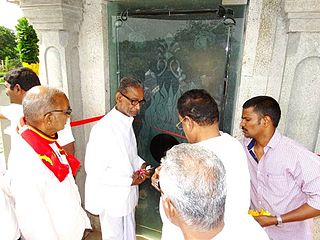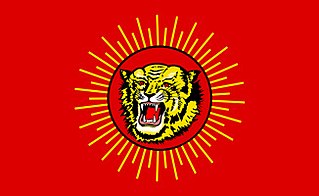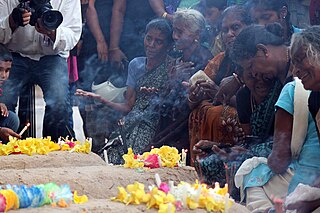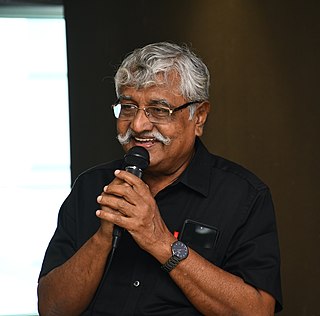
Velupillai Prabhakaran was a Tamil revolutionary. Prabhakaran was a major figure of Tamil nationalism, and the founder and leader of the Liberation Tigers of Tamil Eelam (LTTE). The LTTE was a militant organization that sought to create an independent Tamil state in the north and east of Sri Lanka in reaction to the oppression of the country's Tamil population by the Sri Lankan government. Under his direction, the LTTE undertook a military campaign against the Sri Lankan government for more than 25 years.

Vaiko, birth name Vaiyapuri Gopalsamy, is an Indian politician. He is a member of the Rajya Sabha, the upper house of the Parliament of India from Tamil Nadu. He is the founder and General Secretary of the Marumalarchi Dravida Munnetra Kazhagam (MDMK), a political party active mainly in the Indian state of Tamil Nadu. He was earlier elected to the Lok Sabha, the lower house of the Parliament of India from Sivakasi, Tamil Nadu.

Viduthalai Chiruthaigal Katchi, formerly known as the Dalit Panthers of India or the Dalit Panthers Iyyakkam, is an Indian social movement and political party that seeks to combat caste based discrimination, active in the state of Tamil Nadu. The party also has a strong emphasis on Tamil nationalism. Its chairman is Thol. Thirumavalavan, a lawyer from Chennai, and its general secretary is the writer Ravikumar.
Suppayya Paramu Thamilselvan, commonly known as S. P. Tamilselvan,, was the leader of the political wing of the Liberation Tigers of Tamil Eelam, an organisation fighting for a separate state for the ethnic Tamil minority in the north and east of Sri Lanka from majority Sinhalese government. He was a prominent negotiator and one of the closest associates of LTTE leader Velupillai Prabhakaran.

Senthamizhan Seeman is an Indian film director, actor and politician. He is the leader and chief-coordinator of the Naam Tamilar Katchi political party in Tamil Nadu. He is a strong advocate for regional autonomy and Tamil nationalism by focusing on the Tamil language, identity, and culture.

Pazha NedumaranKrishnan Pillai Pazhaniyappan is an Indian politician from the state of Tamil Nadu, India. He is an ex-national Congressman, a writer and Tamil nationalist, who has authored many books in Tamil and English.

Mahalingam Kanagalingam Shivajilingam is a Sri Lankan Tamil politician, provincial councillor and former Member of Parliament.

Visuvanathan Rudrakumaran is the prime minister of the Transnational Government of Tamil Eelam, which aims to realize accountability for crimes against humanity, war crimes and genocide committed by Sri Lanka against the Tamil minority and to create a separate Tamil state, called Tamil Eelam in Sri Lanka. He was the former legal advisor to the Liberation Tigers of Tamil Eelam (LTTE). By profession he is a lawyer in the United States. He is currently a US citizen and lives in New York City.
The Battle of Aanandapuram was a land battle fought between the Sri Lankan Military, 58 Division, 53 Division and Task Force 8 and the Liberation Tigers of Tamil Eelam (LTTE) for the control of the last stronghold held by the LTTE. This battle is a part of the Northern Theatre of Eelam War IV during the Sri Lankan civil war. The battle was fought in the Aanandapuram area of Puthukkudiyirippu AGA Sri Lanka.
The Indian intervention in the Sri Lankan civil war was the deployment of the Indian Peace Keeping Force in Sri Lanka intended to perform a peacekeeping role. The deployment followed the Indo-Sri Lankan Accord between India and Sri Lanka of 1987 which was intended to end the Sri Lankan civil war between separatist Sri Lankan Tamil nationalists, principally the Liberation Tigers of Tamil Eelam (LTTE), and the Sri Lankan Military.
The Liberation Tigers of Tamil Eelam (LTTE), a separatist militant organization formerly based in northern Sri Lanka, had various organizations affiliated to it. These include charitable organizations, political parties, state intelligence organizations and even governments of Sri Lanka and other countries. Although the LTTE was militarily defeated in 2009, the Sri Lankan government alleges that a number of foreign-based organizations are still promoting its ideology.
The Tamil Eelam Supporters Organization (TESO) was an Eelam Tamil supporters organisation founded in 1985 with Dr. Kalaignar Karunanidhi as president and K. Veeramani and Nedumaran as members for the establishment of an independent Tamil Eelam in the northeast of Sri Lanka.

Naam Tamilar Katchi is a Tamil nationalist political party active in the Indian state of Tamil Nadu and the union territory of Puducherry. It is led by former Tamil actor and film director Seeman. The party is noted for its ideology of Tamil Nationalism. It primarily aims for the creation of a vote bank among Tamils.
The White Flag incident is the massacre of surrendering leaders of the Liberation Tigers of Tamil Eelam and their families by the Sri Lankan Army on 18 May 2009 in Mullivaikal, Mullaitivu, Vanni, Sri Lanka. The LTTE's Political Wing leader, Balasingham Nadesan and Pulidevan agreed to surrender and contacted the United Nations, the governments of Norway, United Kingdom, United States and the International Committee of the Red Cross. They were given assurance by Mahinda Rajapaksa, the Prime Minister of Sri Lanka, and told to surrender at a particular place by Basil Rajapakse. LTTE's request for a third party witness to oversee the surrender was not granted by the Sri Lankan government. The LTTE surrendered to the 58 Division carrying white flags, but were reportedly shot dead. Sarath Fonseka, then the Sri Lankan Army Chief stated that they had been shot dead on the orders of Gotabhaya Rajapaksa to Shavendra Silva, commander of the 58 Division. Balachandran Prabhakaran, Prabhakaran's 12-year-old son, was also killed after surrendering along with his bodyguards. A UN Panel states the LTTE leaders intended to surrender. The Sri Lankan government has denied any accusations of wrongdoing.
Thozhar Thiyagu, also known as Comrade Thiyagu, is a social activist, politician, writer from Indian state of Tamil Nadu. He is also the General Secretary of Tamil National Liberation Movement and is well known for his proficiency in Marxist ideology.

Mullivaikkal Remembrance Day is a remembrance day observed by Sri Lankan Tamils to remember those who were killed during the final stages of the Sri Lankan Civil War. It is held each year on 18 May, the date on which the civil war ended in 2009, and is named after Mullivaikkal, a village on the northeastern coast of Sri Lanka which was the scene of the final battle of the civil war and the site of the Mullivaikkal massacre.
Kopay Army Base is a military base in Kopay, Sri Lanka. The base was built on a Liberation Tigers of Tamil Eelam war cemetery.
Padmanabha murder case was a sensational case during the earlier part of 1990 in Madras in Tamil Nadu, (India) and Sri Lanka. Padmanabha was the leader of EPRLF and he was murdered with 12 of his party men and two commoners in Madras, the capital of Tamil Nadu on 19 June 1990. The incident marked the first occasion when the Liberation Tigers of Tamil Eezham (LTTE), a militant organization, targeted an attack outside Sri Lanka.

Subbaiah Veerapandian, known popularly as Suba Veerapandian or Subavee, is an Indian political activist, author, orator, former Tamil-language professor and former film artist. Since 2007, he has been serving as the general secretary of the Dravida Iyyakka Tamilar Peravai, a Tamil Nadu-based political organisation that aims to promote Ambedkarite, Dravidian and Marxist ideals in the State and elsewhere.
Contributions to popular culture involving direct reference to the Sri Lankan Tamil community in Indian cinema are listed below. All communities that speak Tamil and originally came from Sri Lanka are included. Tamils of Sri Lanka today are a trans-national minority and are found across the globe. While most films on the topic are made in Tamil cinema, there has also been Malayalam and Hindi content on the area.












